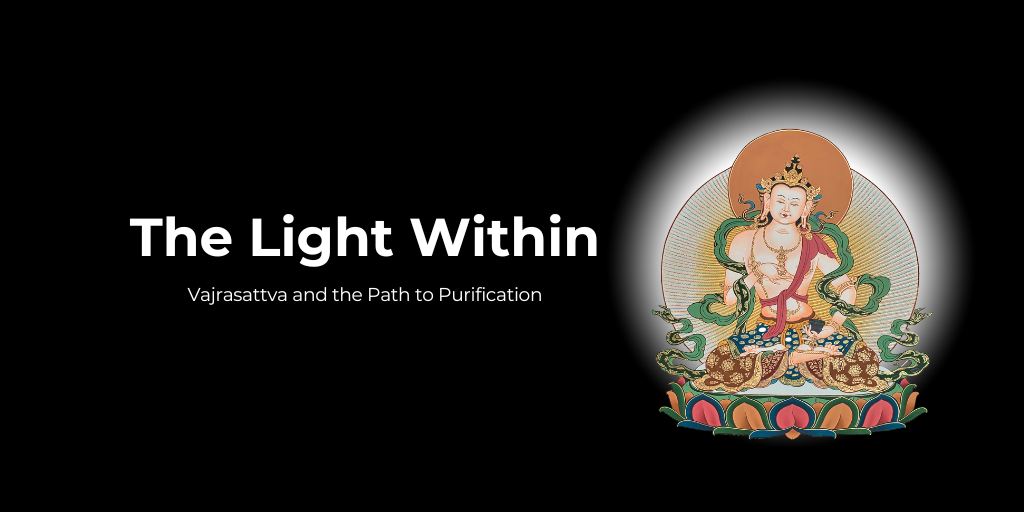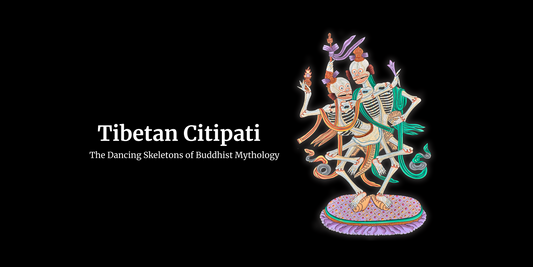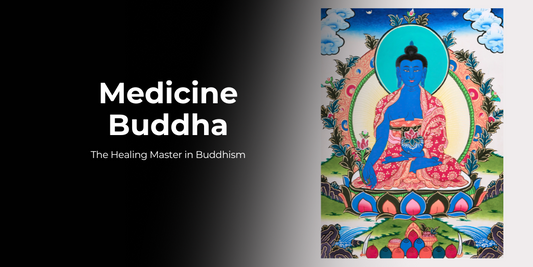- Buddhas Art of Healing
- Thangka
- The Light Within: Vajrasattva and the Path to Purification

The Light Within: Vajrasattva and the Path to Purification
Have you ever heard of a Buddha who clears away negativity like a storm that cleans the sky? That’s Vajrasattva, often called the “Diamond Being.”
The radiant force of purification in Tibetan Buddhism, as he is known for his role in purifying negative karma and restoring inner clarity.
Curious? Let’s step into his world and see what makes Vajrasattva so transformative.
Who is Vajrasattva?
In Sanskrit, Vajrasattva means “Diamond Being.” He is considered the Buddha of purification and embodies the radiant clarity of an awakened mind and the strength to dissolve negativity.
Vajrasattva (Tibetan: Dorje Sempa) is a Sambhogakaya Buddha, representing the luminous, blissful form of enlightened mind. Unlike earthly Buddhas like Shakyamuni, Vajrasattva is not bound to time or space. He arises in meditative visions and tantric practices as the pure essence of all Buddhas.
He is particularly known as the Lord of the Hundred Families, symbolizing universal purification and the removal of defilements.

If you want to invite Vajrasattva's purifying energy into your life, explore our Vajrasattva thangkas to create a sacred presence in your space.
Quick Overview
|
Feature |
Description |
|
Name Meaning |
"Vajra Being" or "Diamond Essence" |
|
Color |
White (symbolizes purity and clarity) |
|
Role in Buddhism |
Buddha of purification, karma cleansing, and tantric preparation |
|
Mantra Focus |
Recitation for purification of body, speech, and mind |
|
Common Practices |
Mantra chanting, visualizations, empowerment ceremonies |
|
Associated Items |
Vajra (dorje) and bell (ghanta), held in his right and left hands |
|
Consort Symbolism |
Represents union of method (compassion) and wisdom |
|
Popular in |
Tibetan Buddhism, especially Nyingma, Kagyu, and Gelug traditions |
Symbolism & Iconography
Vajrasattva’s appearance is rich with meaning. He is most commonly seen:
-
Radiant white, sitting peacefully on a lotus throne.
-
The right hand holds a vajra (dorje) near his heart—symbolizing compassion and indestructible truth.
- The left hand rests on his lap, holding a bell (ghanta)—representing wisdom and the sound of emptiness.
Together, these two symbolize the perfect union of method and wisdom, the path to enlightenment in Vajrayana Buddhism.
Sometimes, he is shown with his consort, representing the dynamic energy of wisdom-in-action. This sacred image reflects the non-dual nature of reality—not sensuality, but symbolic transcendence.

Looking for a visual connection to this symbolism? See our hand-painted Vajrasattva thangkas that capture every sacred detail.
The Vajrasattva Mantra: The Heart of Purification
The Vajrasattva mantra is among the most widely practiced in Tibetan Buddhism. It is used to purify past karma, transform mental obscurations, and cleanse emotional burdens.
The Full 100-Syllable Vajrasattva Mantra:
Om Vajrasattva Samaya / Manupalaya Vajrasattva Tenopa Tishtha / Dridho Me Bhawa / SutoKhayo Me Bhawa / SupoKhayo Me Bhawa / Anurakto Me Bhawa / Sarwa Siddhi Me Prayaccha / Sarwa Karma Su Tsame / Tsittam Shriyam Kuru Hung / Ha Ha Ha Ha Ho / Bhagawan Sarwa Tathagata Vajra Ma Me Munca / Vajri Bhawa Maha Samaya Sattva Ah Hum Phat
Even chanting the short version—“Om Vajrasattva Hum”—with deep intention carries immense cleansing power.
Many practitioners chant it 100,000 times as part of Ngöndro (preliminary practices) to purify body, speech, and mind before advanced tantric initiations.
Why Practice Vajrasattva? (And What You Gain)
Vajrasattva’s practice is not just spiritual—it’s profoundly healing and psychological. It directly helps with:
|
Benefit |
Explanation |
|
Karmic Purification |
Clears negative karmas and habitual patterns |
|
Emotional Healing |
Releases guilt, shame, regret, and emotional heaviness |
|
Energetic Cleansing |
Opens subtle channels, balances chakras, prepares for deeper meditation |
|
Spiritual Preparation |
Essential before receiving tantric empowerments or advanced practices |
|
Mental Clarity |
Enhances focus, peace of mind, and inner brightness |
Practitioners often say that after Vajrasattva retreats or mantra accumulation, they feel lighter—almost like dropping spiritual “weight” they didn’t know they were carrying.
Vajrasattva Empowerment 2024: What You Need to Know
Every year, Buddhist centers around the world offer Vajrasattva empowerment ceremonies. These are initiations into the practice, allowing you to form a sacred bond with the deity and engage in visualization and mantra with greater potency.
What Happens During an Empowerment?
- Transmission of Vajrasattva’s blessings by a qualified lama
- Visualizations and mantras performed as a group
- Initiation into Vajrasattva’s practice lineage
These events are particularly valuable if you’re looking to begin or deepen your purification practice in 2024.
To find a Vajrasattva empowerment in 2024, check listings at trusted monasteries or Buddhist centers like:
- FPMT Centers
- Rigpa International
- DharmaSun
-
Kagyu Samye Ling Monastery
Thangkas, Statues & Pictures
Bringing home a Vajrasattva Thangka, statue, or picture serves as both a devotional and spiritual act. These sacred items can:
- Support daily mantra practice
- Enhance altar or meditation spaces
- Act as constant reminders of purity and discipline
Types of Art Available:
|
Art Form |
Description |
|
Thangka Paintings |
Hand-painted scrolls rich in symbolism, often consecrated by monks |
|
Bronze Statues |
Made with traditional casting methods, ideal for altars |
|
Print Pictures |
Affordable, ready-to-frame artwork for beginners or travel use |
Choose art that resonates with you—sometimes, the image itself becomes a gateway into deeper practice.
See our full collection of Vajrasattva thangkas to find the piece that calls to you.
Core Message: You Are Already Pure
Vajrasattva’s teachings remind us that beneath our layers of fear, confusion, and mistakes, we are already whole and luminous. His practices don’t make us better—they unveil what has always been pure.
Unlike deities based on mythology or earthly life, Vajrasattva exists beyond time, arising whenever there is a sincere wish to heal, grow, and awaken.

1. Is Vajrasattva part of mainstream Buddhism?
Vajrasattva is most prominent in Vajrayana Buddhism, especially Tibetan traditions. However, his message of purification applies universally.
2. Do I need empowerment to chant the mantra?
No. While empowerment adds depth, anyone can recite “Om Vajrasattva Hum” with faith and sincerity.
3. What’s the meaning behind Vajrasattva’s consort?
His consort symbolizes wisdom. Together, they reflect the essential union of compassion and wisdom—required for enlightenment.
4. Is it okay to hang a Vajrasattva Thangka in my home?
Absolutely. Place it in a respectful area like a meditation space or altar. Treat it with care and mindfulness.
5. How long should I chant the mantra?
Even 10 minutes daily creates a shift. Traditional practice involves 100,000 recitations for deep karmic purification.
Conclusion: Let Vajrasattva Guide Your Inner Cleanse
Whether you're just starting your journey or looking to deepen your practice, Vajrasattva is a perfect guide for healing, forgiveness, and transformation.
His mantra purifies.
His image inspires.
His presence awakens your truth.
If you’ve ever felt weighed down by past actions, inner guilt, or confusion, Vajrasattva gently reminds you: you are not broken—you are becoming.
Ready to begin? Explore our Vajrasattva collection, from Buddha's Art of Healing, to bring purity, clarity, and compassion into your life.



